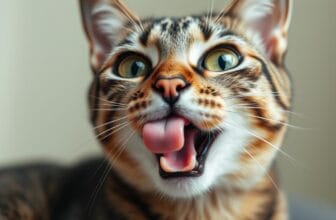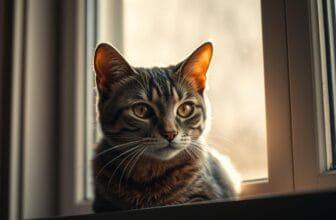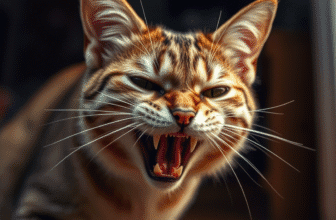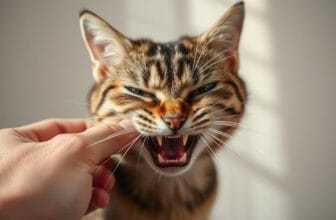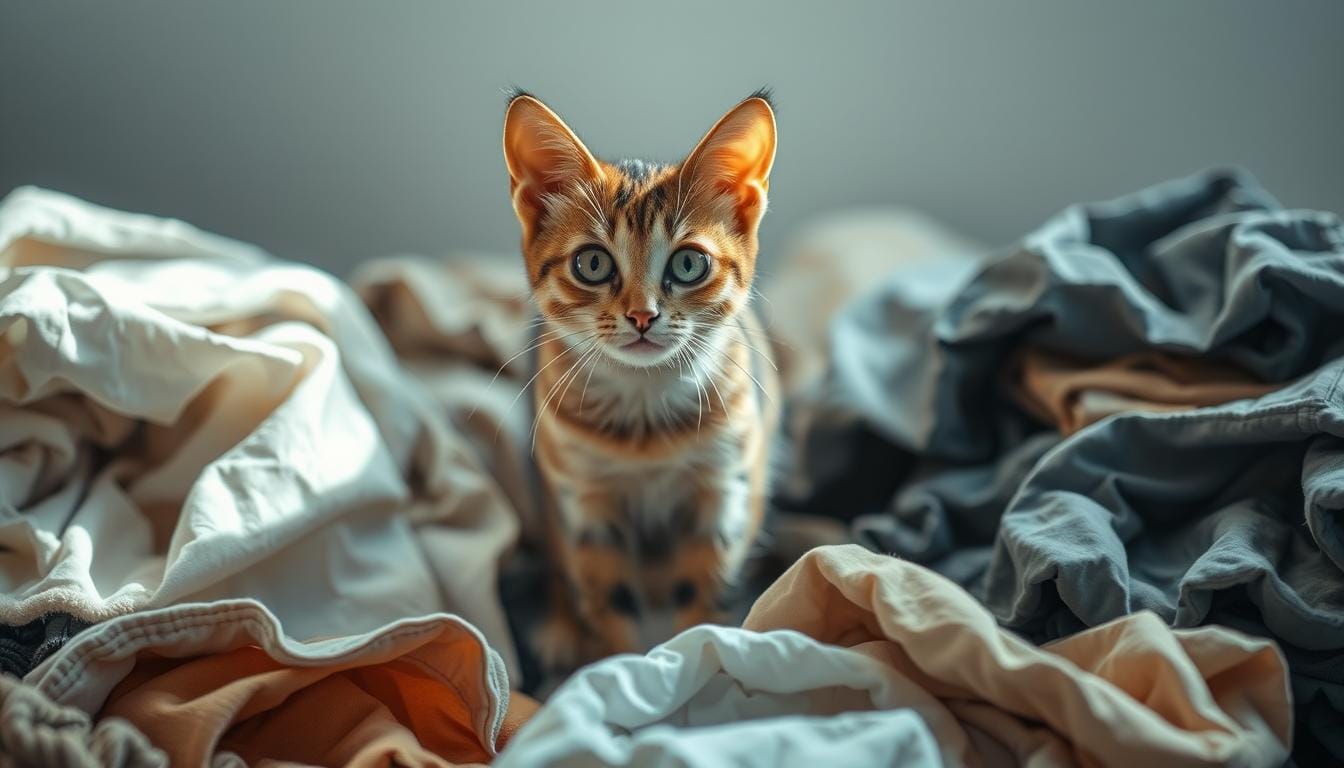
Table of Contents
Does your pet suddenly treat your freshly washed laundry like a personal bathroom? This puzzling behavior often leaves owners scrambling for answers—and odor-free solutions. While frustrating, unexpected urination habits rarely happen without reason.
Your feline’s actions could signal hidden health concerns or environmental stress. Conditions like kidney disease or FLUTD often drive sudden changes in bathroom behavior. Even minor discomfort can push pets to seek softer surfaces, like piled clothes, for relief.
Stress plays a role too. New pets, loud noises, or rearranged furniture might make your companion anxious. Their scent-marking on familiar fabrics becomes a misguided attempt to reclaim territory. Laundry piles absorb their smell, creating a false sense of security.
Litter box issues also contribute. A dirty tray, uncomfortable litter texture, or inconvenient location can deter use. Some cats avoid covered boxes entirely, preferring open spaces like your laundry basket.
This article explores both medical and behavioral roots behind this messy habit. You’ll learn practical steps to address health worries, reduce stress triggers, and create litter box setups your pet actually wants to use. Let’s turn those frustrating accidents into solved mysteries.
Understanding the Behavior Behind Cat Peeing on Clothes
Your pet’s sudden preference for soft fabrics over their usual bathroom spot isn’t random. It’s often a blend of instinct and emotional needs shaping their actions.
Exploring Comfort, Scent, and Familiarity
Fabrics carrying your unique smell act like a security blanket. Your scent triggers calmness, making piled laundry feel like a safe zone. This explains why items you’ve worn recently become targets.
Animals seek soft textures when stressed or unwell. Fluffy towels or sweaters mimic the comfort of nesting areas they’d choose in the wild. If their litter box feels harsh or unfamiliar, softer alternatives win.
Identifying Environmental Stressors and Changes
Sudden shifts in routine or surroundings often spark anxiety-driven habits. Common triggers include:
- New pets disrupting established territories
- Loud appliances near resting areas
- Furniture rearrangements altering “safe” pathways
Watch for patterns. Accidents occurring after specific events—like construction noise or guest visits—reveal stress connections. Creating predictable routines helps rebuild their confidence.
Medical Causes of Cat Peeing on Clothes
When pets avoid their litter box, hidden health issues often play a role. Physical discomfort or chronic diseases can make standard bathroom habits impossible. Recognizing these red flags helps you act quickly before minor issues escalate.
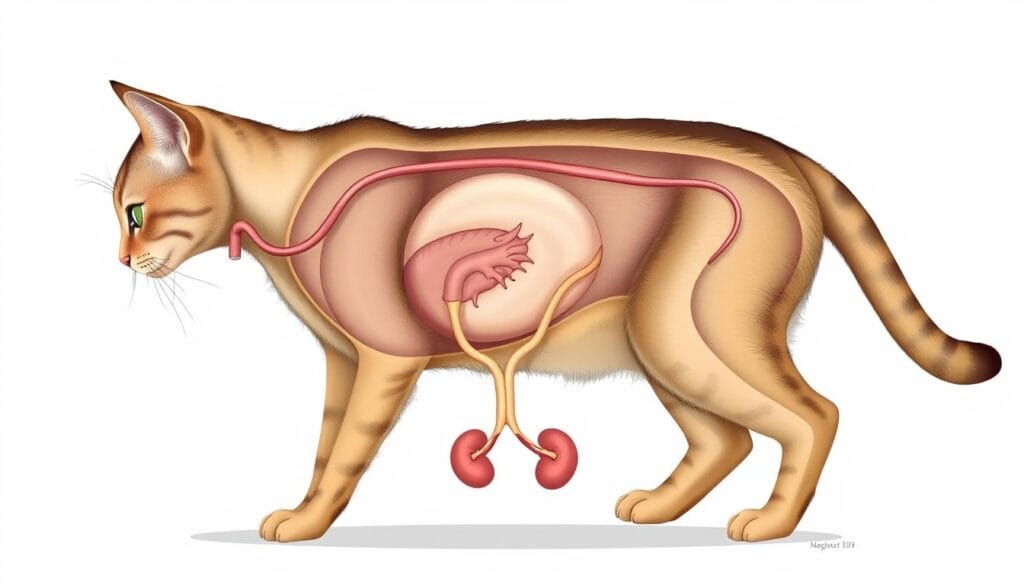
Urinary Tract Issues and Kidney Conditions
Urinary tract infections (UTIs) create burning sensations during elimination. Cats may associate their litter box with pain, seeking softer surfaces like laundry piles. FLUTD (Feline Lower Urinary Tract Disease) causes similar distress, often linked to bladder inflammation or blockages.
Bladder stones amplify discomfort, sometimes causing bloody urine. These mineral formations irritate the urinary tract, making frequent, strained trips to the bathroom common. Kidney disease also alters elimination patterns, as weakened organs struggle to filter waste efficiently.
Age-Related Health Concerns and Chronic Conditions
Senior pets face unique challenges. Arthritis makes climbing into high-sided litter boxes painful, while cognitive decline leads to confusion about bathroom locations. Conditions like diabetes or thyroid imbalances increase thirst and urination frequency, raising accident risks.
Watch for warning signs: straining, vocalizing during elimination, or blood-tinged urine. These symptoms demand immediate veterinary attention. Early diagnosis of kidney issues or tract infections often leads to better management through diet changes or medication.
Never assume accidents are purely behavioral. Schedule a vet visit if patterns persist—untreated UTIs can become life-threatening within days. Your pet’s health depends on swift, professional evaluation.
Behavioral Triggers Leading to Cat Peeing on Clothes
Understanding the motives behind this messy behavior starts with behavioral cues. Pets often communicate unmet needs through actions that puzzle owners. Let’s decode two key psychological drivers behind fabric-targeted accidents.
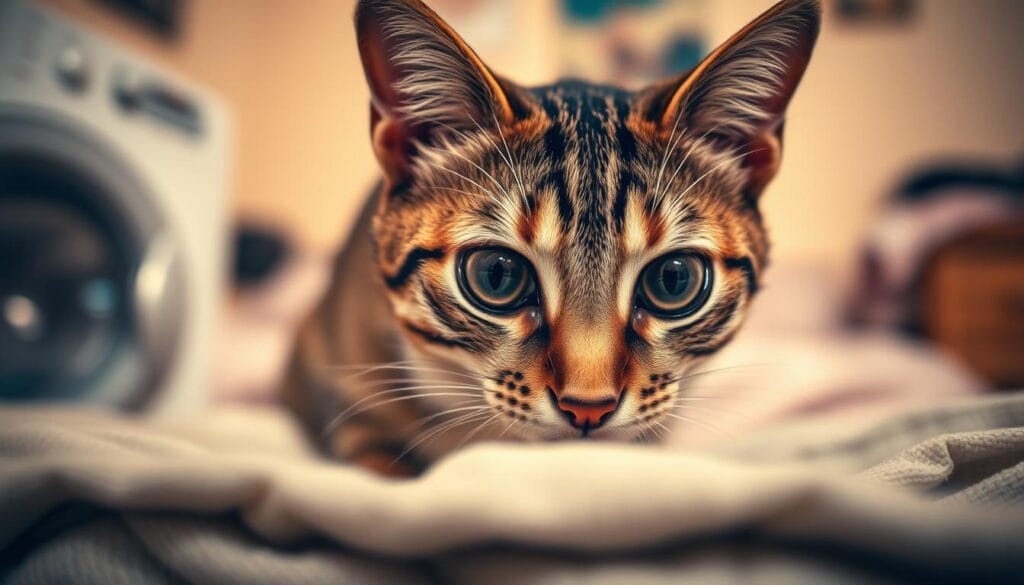
Marking Territory and Attention-Seeking Behavior
Pheromones in urine act as invisible “claim tags” for animals. Items carrying your scent—like worn shirts—become prime targets for marking. This instinctual habit reinforces their bond with you while asserting ownership. Even spayed pets may exhibit this behavior during household changes.
Attention-seeking often escalates when routines shift. A single accident on your sweater can spark immediate interaction, teaching pets that this tactic works. “Negative attention is still attention,” explains a feline behavior specialist. Consistent playtime and scheduled feeding reduce these bids for engagement.
Stress, Anxiety, and New Pet Dynamics
Introducing another animal disrupts established hierarchies, triggering insecurity. Your laundry pile becomes a scent-soaked safe zone during these transitions. Common stressors include:
| Trigger | Behavioral Response | Solution |
|---|---|---|
| New pet arrival | Increased marking near owner’s belongings | Separate feeding areas + gradual introductions |
| Loud noises | Hiding + accidents in quiet zones | White noise machines + covered beds |
| Schedule changes | Demand vocalization + targeted urination | Interactive toys + predictable routines |
Distinguishing medical issues from behavioral ones remains critical. Watch for these signs:
- Vertical spraying (marking) vs. horizontal puddles (health concerns)
- Accompanying changes in appetite or grooming
- Frequency of incidents after specific triggers
Addressing root causes—not just symptoms—creates lasting solutions. Pair environmental adjustments with positive reinforcement to rebuild trust and routine.
Troubleshooting Litter Box Related Issues
What drives pets to avoid their bathroom station despite proper training? Often, the answer lies in overlooked details that clash with their instincts. Solving elimination issues requires examining both physical setups and sensory preferences.
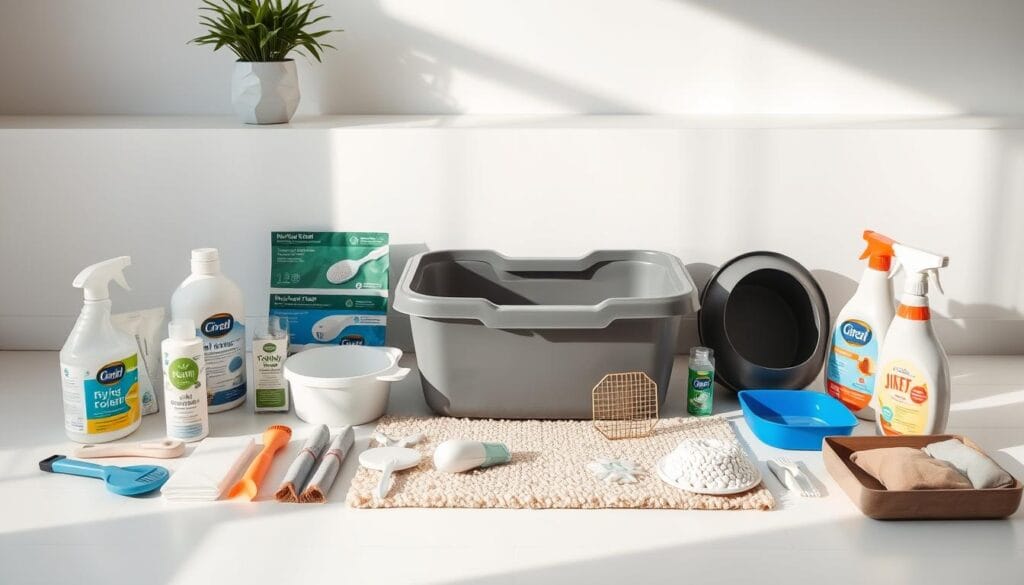
Litter Box Cleanliness and Accessibility
A dirty or poorly placed bathroom area becomes an instant dealbreaker. Daily scooping and weekly deep cleaning prevent odor buildup that repels sensitive noses. Place boxes in quiet corners—high-traffic zones create stress during vulnerable moments.
Older pets or kittens need low-entry designs. Arthritis makes climbing difficult, while shallow trays help smaller animals enter easily. Ensure each floor has at least one station, especially in multi-level homes.
Experimenting with Litter Types and Box Placement
Texture matters more than you think. Some refuse gritty options, favoring smooth silica or soft paper pellets. Unscented varieties often work best—strong perfumes overwhelm their keen sense of smell.
| Litter Type | Best For | Common Issues |
|---|---|---|
| Clumping clay | Odor control | Dust irritates airways |
| Recycled paper | Post-surgery recovery | Less odor absorption |
| Walnut shells | Eco-conscious owners | Uneven texture |
Test placements through trial periods. Move rejected boxes 2-3 feet weekly until finding a spot they accept. Avoid placing near loud appliances or other pets’ resting areas.
If accidents occur outside the litter box, add extra stations with different substrates. This strategy identifies preferences while reducing stress-related incidents.
Practical Solutions to Stop Cat Peeing on Clothes
Addressing unexpected bathroom habits requires both prevention and patience. Strategic changes to your space and routines can transform frustrating accidents into manageable situations.
Establishing a Stress-Free, Secure Environment
Predictable schedules reduce anxiety-driven marking. Feed your pet at consistent times and maintain regular play sessions. Create designated safe zones with elevated perches or enclosed beds away from household traffic.
Use synthetic pheromone diffusers near favorite resting spots. These mimic natural calming scents, easing tension during disruptions like moving furniture or hosting guests. Keep laundry baskets closed or stored in closets—accessible piles tempt stressed animals.
Effective Cleaning Techniques and Odor Removal
Enzyme-based cleaners break down urine molecules completely, eliminating lingering smells that attract repeat incidents. Avoid ammonia-based products—their scent resembles animal waste. For stubborn stains, apply white vinegar before washing to neutralize odors.
Reinforce litter box appeal by placing multiple options in quiet home areas. Try unscented, fine-grained litter in open trays. Reward proper bathroom behavior with treats or affection to build positive associations.
Consistency matters. Store soiled laundry immediately and vacuum floors weekly to remove stray hairs. Your efforts create a harmonious space where your companion feels secure—and your clothes stay fresh.
Conclusion
Resolving fabric-related accidents demands a holistic view of your companion’s needs. Medical issues, environmental stressors, and litter box preferences often intertwine, creating complex behavioral patterns. Ignoring one factor could leave other triggers unresolved.
Start by ruling out health concerns with a veterinarian visit. Urinary infections or chronic conditions frequently drive sudden changes. Simultaneously, assess your home for anxiety triggers—new pets, loud spaces, or disrupted routines can shake their sense of security.
Adjustments matter. Experiment with litter textures and box placements while maintaining rigorous cleanliness. Use enzyme cleaners to erase odors completely, preventing repeat incidents. Reinforce positive habits through consistent rewards and stress-reduction tactics like pheromone diffusers.
Patience proves vital. Some solutions take weeks to show results. Track patterns diligently—does the behavior spike after specific events? Your observations become critical clues.
By addressing both physical discomfort and emotional needs, you rebuild trust. A calm environment paired with professional guidance transforms confusion into clarity, restoring peace for you and your pet.
FAQ about cat peeing on clothes
Why does my pet avoid the litter box and target laundry?
Your furry friend might associate soft textures like clothes with safety, especially if stressed. Medical issues like urinary tract infections or bladder stones can also cause discomfort, leading them to seek alternative spots.
How do environmental changes trigger this behavior?
New pets, moving furniture, or loud noises can disrupt their routine. These stressors make them feel insecure, prompting territory marking or hiding in scent-familiar areas like laundry piles.
What health problems lead to inappropriate urination?
Kidney disease, diabetes, or arthritis can make accessing the litter box painful. Urinary tract infections often cause urgency, so they might not reach the box in time. Always consult a vet to rule out these conditions.
Could my pet be marking territory on purpose?
Yes. Unneutered males or multi-pet households often spray to claim space. Even spayed pets may mark if they feel threatened. Using enzymatic cleaners removes odors that encourage repeat incidents.
Does litter type affect where they go?
Absolutely. Some dislike scented or coarse textures. Try unscented, clumping options and ensure boxes are easily accessible. Place multiple boxes in quiet areas to reduce competition in multi-pet homes.
How can I prevent accidents on fabrics?
Store laundry in closed hampers and provide cozy resting spots away from busy areas. Use pheromone diffusers to ease anxiety, and clean soiled items immediately with enzyme-based solutions to eliminate lingering smells.
Sources:
Why Is My Cat Peeing On Laundry? | Atlantic Veterinary Hospital
Explores medical, behavioral, and litter box-related causes for cats urinating on laundry, emphasizing the importance of veterinary consultation.
https://atlanticvetseattle.com/why-is-my-cat-peeing-on-laundry/
Why Does My Cat Pee on My Clothes: Causes and Remedies | Petpedia
Discusses various medical conditions and behavioral issues that may lead to this behavior, along with potential solutions.
https://petpedia.co/why-does-my-cat-pee-on-my-clothes/
Why Does My Cat Pee on Laundry? | Brown Veterinary Hospital
Offers insights into behavioral modifications and deterrents to prevent cats from urinating on laundry.
https://brownvethospital.com/blog/cat-pees-on-laundry/
Why is My Cat Peeing on My Clothes? | PrettyLitter
Explains scent and comfort-seeking behaviors in cats that may lead them to urinate on clothing.
https://www.prettylitter.com/blog/cat-peeing-on-clothes
Why Is My Cat Peeing on My Clothes? Tips to Stop It (Vet Answer) | Catster
Provides veterinary advice on addressing inappropriate urination, including environmental enrichment and litter box management.
https://www.catster.com/ask-the-vet/why-is-my-cat-peeing-on-my-clothes/
Why Does My Cat Pee on My Clothes? Reasons and Solutions | Kinship
Details medical and behavioral reasons for this behavior and offers practical solutions to address it.
https://www.kinship.com/cat-behavior/why-does-my-cat-pee-on-my-clothes
How to Stop Your Cat from Peeing on Clothes and Dog Beds | JustAnswer
Discusses cleaning techniques and behavioral strategies to prevent repeat incidents.
https://www.justanswer.com/cat-health/fo6qt-cat-peeing-boyfriends-stuff-dog.html
Why Does My Cat Pee on My Clothes? How to Get Your Cat to Stop | The Advisor Coach
Explores territorial and stress-related causes and offers preventive measures.
https://www.theadvisorcoach.com/cat-peeing-on-clothes.html
Why do cats pee on clean clothes in a basket.and how do you stop it? | JustAnswer
Addresses common causes and provides expert advice on preventing this behavior.
https://www.justanswer.com/pet-cat/20oxi-cats-pee-clean-clothes-basket-and.html
How to Get Cat Pee Smell Out of Clothes & Bedding | The Spruce Pets
Offers detailed steps for removing cat urine odors from fabrics and emphasizes addressing underlying issues.
https://www.thesprucepets.com/remove-urine-odor-from-laundry-555190



